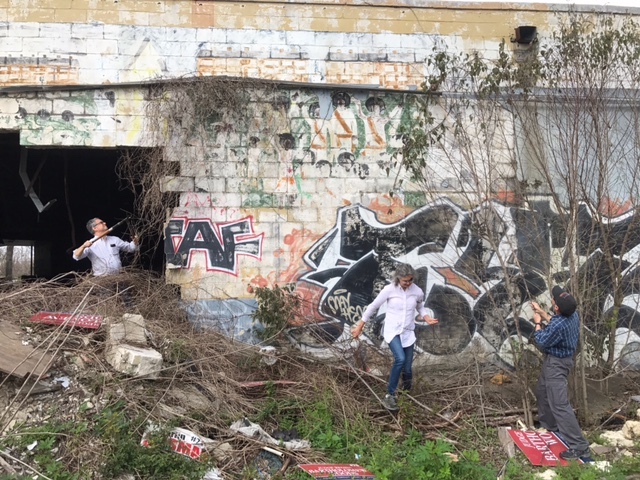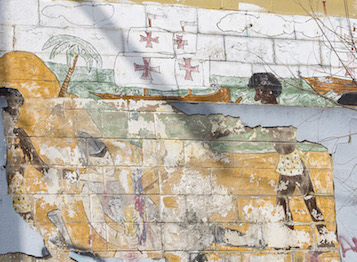
On a partially sunny Tuesday morning in February four cultural experts from the Louisiana State Museum waded with me through weeds and detritus to pull vines and cut trees away from the back wall of an old shopping mall. Owned by the Desire Community Housing Corporation, the old mall stands on an otherwise vacant block on the eastern edge of the Upper Ninth Ward, a desolate space forgotten by all the world, except for the occasional squatter and a cluster of graffiti artists.
Amid the debris, Greg Lambousy, Director of the New Orleans Jazz Museum, spotted a long iron rod with a curve like a shepherd’s crook and used it to pull down a gutter.
We were trying to get a better look at what we’ve come to call the “Panther mural.” Painted on cinder block, covered over with stucco years ago and relegated to oblivion, it appeared to embody themes of African-American empowerment and militancy from the era of black nationalism.
Also relegated to oblivion, except in the minds of a few, is the memory of how powerful the New Orleans Panthers were in 1970 when they took up residence in a Desire Public Housing Development unit and vowed to stay there to protect residents from police.
Champions of the poor, unifiers, revolutionary educators, the Panthers were dreaded by some — including FBI director J. Edgar Hoover who vowed to eradicate them — and a source of inspiration to others. As I explain in my book, “Showdown in Desire: The Black Panthers Take a Stand in New Orleans,” believers saw them as a divinely protected force for good.
After our strenuous, resourceful, and somewhat dangerous clearing efforts, photographer Mark Sindler got a pretty clear angle on the mural where the stucco had fallen away. Propitiously, just then the sun came out.
If you follow the wildly improbable twists and turns of this story, you could conclude that we, all of us, are being led to pay attention, to notice something that has revolutionary and artistic relevance to New Orleans history.
The recent chapter in a long saga began last spring when a young doctor named Joe Fraiman, chief medical resident at the LSU Medical Center, was driving home from a search-and-rescue training session and a detour took him by the abandoned, grafitti-splashed mall. “It had a presence to it. I had my rescue boots on, and I enjoy these kind of impressive spaces,” Joe told me, so he stopped to take a look.
Now the challenge is to find a home for this relic from the city’s historical past, so long protected by our obliviousness to it.
On closer inspection, what caught his eye was a well-preserved art work slowly revealing itself as the stucco fell away from one exterior wall. “There’s something very special here,” he texted fellow medical resident Jenn Hissett who is also an archaeologist. Soon a small group of us were speculating about what this art work could be or mean.
On May 6, I got an email from Ricardo Coleman. An adjunct professor at Delgado Community College, he had seen my article in The Lens:
“I actually grew up across the canal in the Florida Housing Projects on Florida Ave. But I used to walk to Bynum’s Pharmacy which was in the building that contains the mural,” Coleman wrote. “I had not seen it since I was a child. Around 1984-85, during the administration of [New Orleans Mayor] Dutch Morial, that particular piece of property was renovated and renamed Desire Square. The mural was emblazoned on the back side of the building.
“When Desire Square opened, I had assumed that the previous building had been torn down, and the mural was lost to history. So, imagine my surprise when I read your story and learned that it still exists. I can certainly remember that it contained violent and powerful images that stirred up many emotions when I first saw it. Initially, I was afraid of it. I just didn’t understand what it all meant. I can tell you that it definitely seemed to tell a story. But, it also caused me to ask questions about it, and I think maybe that was the beginning of my love affair with history.
“I decided to ask around and find out anything that I could about it. What was interesting is that at that time, some felt it was a blight on the neighborhood. In Desire?! Imagine that! In any event, one of my teachers told me that it was erected shortly after the Black Panthers’ confrontation with the NOPD. It was intended to educate young people just like me about the history of black people in America. I can also remember that while everything in the neighborhood was ‘fair game’ for graffiti, no one ever tagged the mural even back then. …”
Coleman’s recollection supported Joe’s and my assumption that the mural dated to the Panther era, but who had created it? Who was the artist?
A few months later, I was at a Panther reunion panel organized by Malik Rahim, a Panther back in the day who had gone on to a heroic role in the Hurricane Katrina recovery effort as founder and head of the community group, Common Ground.
After the discussion, I approached a man named Wesley Philips who had made comments from the audience that suggested he might know more about the mural. He said he had lived in Desire from 1956 until 1981 and that he remembered the mural well. He confirmed Coleman’s hunch that the artist was probably Bruce Brice, a distinguished New Orleans painter among whose accomplishments was the design of the very first Jazz Fest poster in 1970.
Bruce died two years ago at the age of 72. But his website is still up and running and so I gave it a look. There, right at the top, stood a decades-old photograph of the mural as it looked when newly painted. You can imagine my surprise and delight. It was the eureka moment. Any need for guesswork about the mural’s origins had been eliminated. But I was still curious to learn more.
Lens opinion editor Jed Horne, who had put Fraiman in touch with me, now connected me with Brice’s widow Jackie, having dined with the couple and their son, Eben, shortly before Bruce died. Jackie welcomed our interest.

The web page shed light on Brice’s purposes as an artist and his fascination with the visual textures, communities and architecture of New Orleans: “I am an artist educating the masses. My goal is to teach . . . to enlighten others about the rich African American experiences, culture, and traditions in this region,” he wrote. “Through various mediums, I am able to link the past to the present and form positive visions of the future.”
Eben Brice, a local businessman in his 30s, was especially pleased by the discovery of his father’s work, slowly coming to life behind the crumbling stucco. Here was proof of something he had only heard about: his father’s social activism as he made the transition to full-time artist in the decade before his son’s birth. The mural, Eben said, was a “living legacy,” evidence of his father’s impact on the city, socially as well as artistically.
Just as I was mulling over how in the world this historical treasure could be documented, appreciated and preserved, Tulane professor and historian Lawrence Powell called me on another matter. Powell has great ideas about how to get just about anything done, so I asked him for advice on preserving the mural. He said would get right on it and, in his capacity as chairman of the board of the Louisiana State Museum, he did.
Which is how I ended up in a pile of rubble with a gaggle of museum experts wielding crudely improvised clearing tools.
That’s the latest in a series of improbable occurrences. No doubt there will be others as this piece circulates and the ghosts of our revolutionary past crawl out of cracked stucco and and rubbish and years of neglect and clamor to be seen and heard.
Now the challenge is to find a home for this relic from the city’s historical past, so long protected by our obliviousness to it.
Orissa Arend is a mediator, psychotherapist, and author of “Showdown in Desire: The Black Panthers Take a Stand in New Orleans.” You can reach her at arendsaxer@bellsouth.net.
The Lens opinion section is a community forum. Views expressed are not necessarily those of The Lens or its staff.


